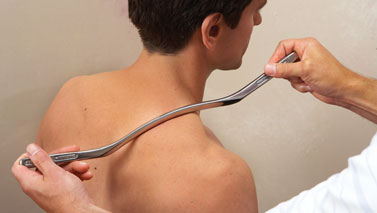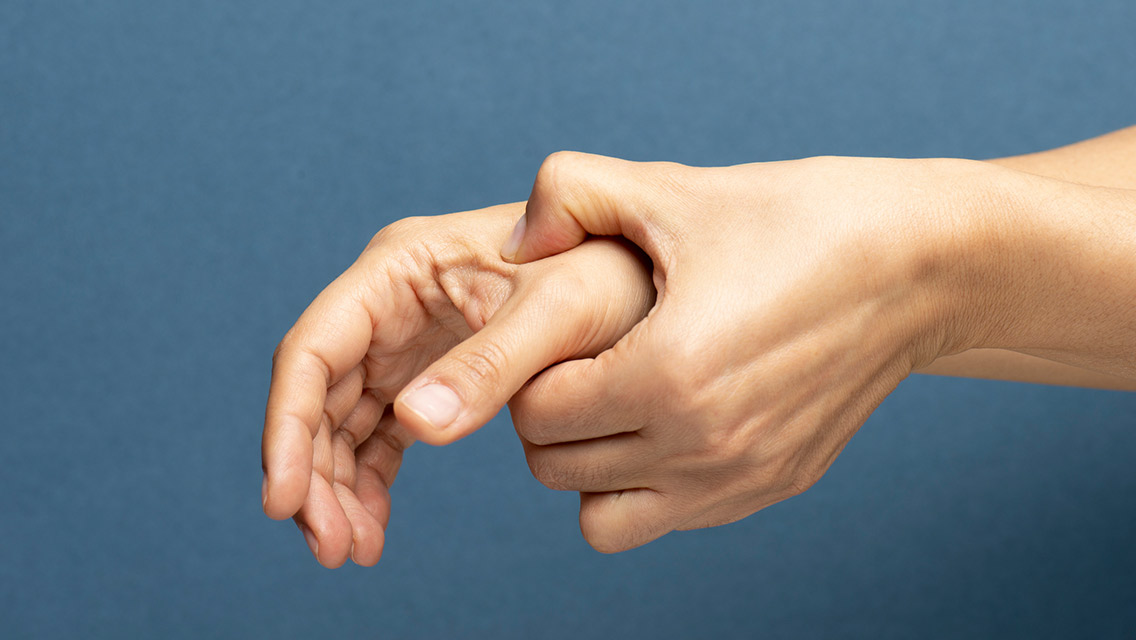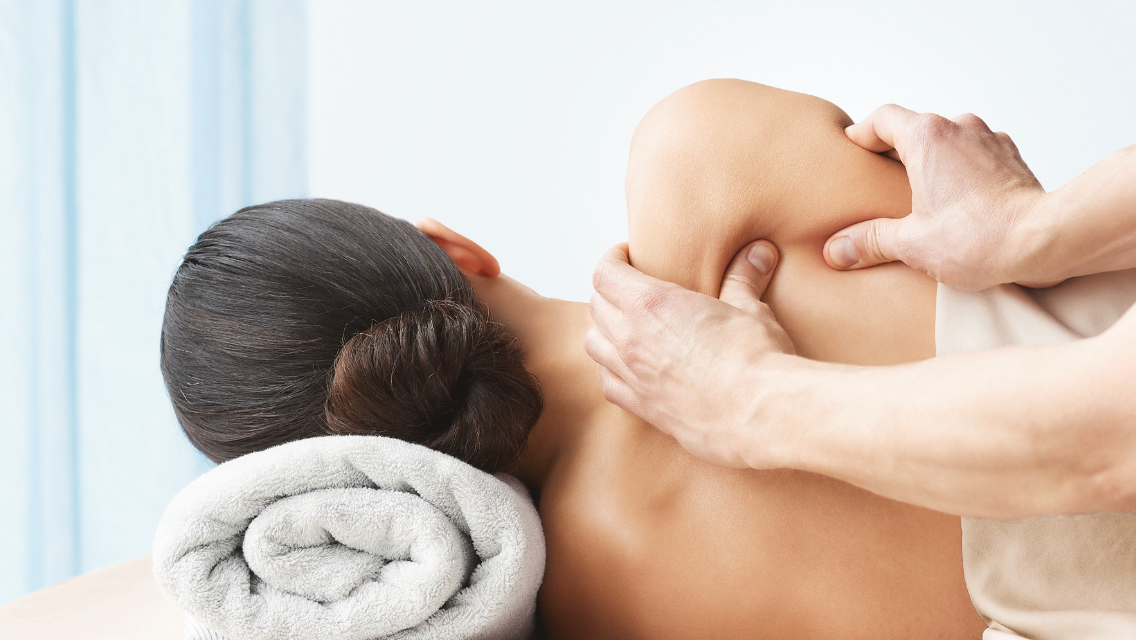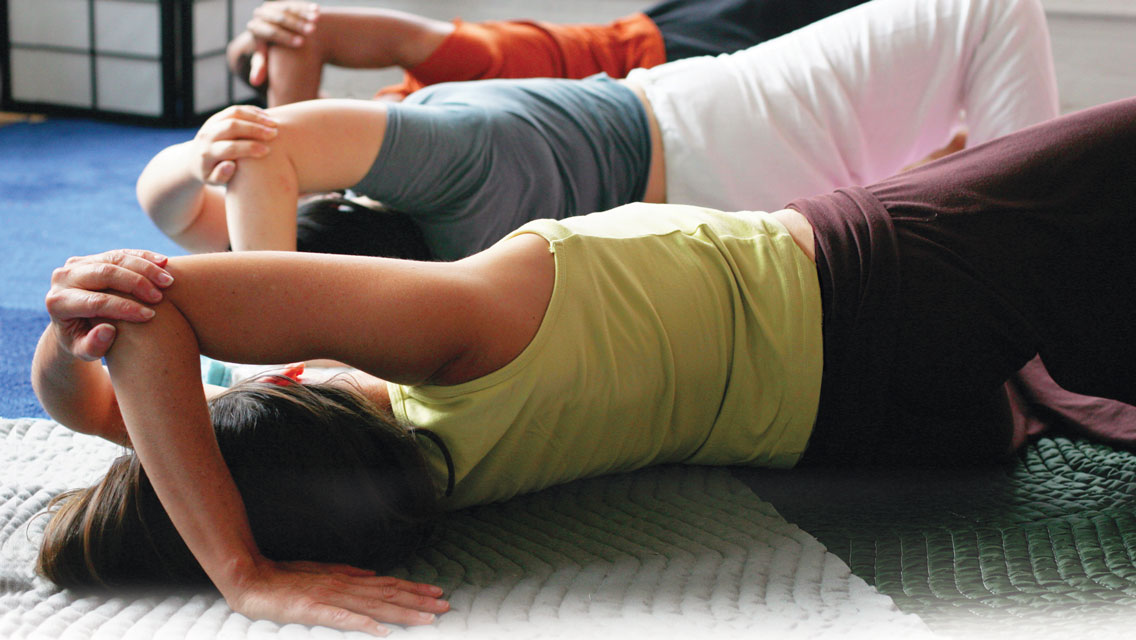After knee-replacement surgery and multiple rounds of physical therapy, Roberta Gunderson, 53, was feeling like the Bionic Woman — that is, if the Bionic Woman had been left in the rain to rust. “I felt very stiff and robotic in the beginning,” says Gunderson of her recovery. “Like I was Frankenstein’s monster.”
Doctors told Gunderson, a biology professor at Wilbur Wright College in Chicago, that her postsurgery progress had plateaued and that her knee would likely not gain more than 106 degrees of flexion — far from the ideal 120 degrees. An avid cyclist, swimmer and golfer, Gunderson was determined to regain her former mobility, so she opted for a treatment called the Graston Technique (GT), a form of soft-tissue mobilization that detects and breaks up scar tissue that impedes normal function of muscles, fascia, tendons and ligaments. Clinicians rub stainless-steel instruments over the injured area, as if trying to iron out tangled tissue.
After four weeks and seven treatment sessions, Gunderson’s knee went from 106 degrees of flexion to 116 degrees. “I was amazed at how much I improved in only a month,” she says.
An Instrumental Change
The Graston Technique is a type of cross-fiber massage — a noninvasive, drug-free procedure that uses ultraprecise stainless-steel instruments to break up restrictive scar tissue. These instruments can be far more effective than a clinician’s hands alone because they are able to concentrate force while giving excellent feedback to both the clinician and the patient. (It’s worth noting, however, that GT is often used in conjunction with other therapies that involve hands, foam rollers and knobs.)
GT is used to treat a wide range of soft-tissue ailments, from tennis elbow to plantar fasciitis, because clinicians can easily adapt the technique to the situation and zero in on the offending area. “We are now able to diagnose things that used to go undetected,” says Ted Forcum, DC, DACBSP, owner of Back In Motion Sports Injuries Clinic in Beaverton, Ore.
When the clinician runs an instrument over scar tissue, she can feel exactly what’s happening under the skin. “It’s like when you were a kid and you put a leaf underneath some paper and colored over it. But instead of an imprint of the leaf, you get a picture of the injury,” says Forcum, who used GT to treat U.S. Olympians in Beijing.
Smoothing Out the Edges
A lot of soft-tissue problems occur within the fascia, the web of connective tissue that supports muscles and organs and prevents us from melting into formless blobs. If you suffer an injury, however, the fascia tends to attempt to stabilize the area by binding to the muscles like poorly applied wallpaper, complete with air bubbles and clumsy adhesions. GT instruments smooth out those air bubbles.
“We’ve found that injured ligaments treated with GT showed accelerated healing in the short term and a clear increase in strength compared to injured ligaments that weren’t treated with GT.”
If not addressed, these adhesions can cause an avalanche of kinetic chaos, because when a muscle or group of muscles becomes incapacitated, all the surrounding muscles, tendons and ligaments have to pick up the slack — which eventually causes them to become overworked and fatigued. Your only option: Break down the adhesions so you can rebuild a healthy balance.
The approach seems to be effective. “We’ve found that injured ligaments treated with GT showed accelerated healing in the short term and a clear increase in strength compared to injured ligaments that weren’t treated with GT,” says Terry Loghmani, PT, MS, MTC, associate clinical professor of physical therapy at Indiana University in Indianapolis.
Hurts So Good
Because GT involves direct manipulation of stuck tissue, patients can expect some discomfort during the procedure. “But it should never produce pain that’s intolerable,” says Richard E. Vincent, DC, who uses GT in his Falmouth, Mass., clinic. Patient and clinician should work together to figure out the appropriate intensity levels.
After treatment, some soreness, bruising and swelling is actually desirable because it means the body is replacing adhesed tissue with healthy, linear tissue.
“With most patients, we will wait a day or two between treatments, but others — especially athletes — are accustomed to working through benign pain and use GT every day because they have to recover fast and perform,” says Valli Gambina, DC, a chiropractic sports physician in Venice, Fla.
After treatment, some soreness, bruising and swelling is actually desirable because it means the body is replacing adhesed tissue with healthy, linear tissue.
Smooth Operators
Sessions usually last about an hour, during which the clinician uses GT for only about five to eight minutes on each injured area. The rest of the time is dedicated to assessment, warming up, stretching and icing.
Unlike some other types of treatment, patients using GT can’t just kick back and let the practitioner do all the work. After treatment, patients must continue to stretch and strengthen the injured area. While it might seem counterintuitive to work an injured area, the immediate movement helps the tissue heal correctly.
Most patients will begin to notice positive results after three or four sessions, with treatment lasting about eight to 10 sessions. But some will experience results even faster. After her first session, Gunderson said she immediately felt looser and more flexible.
There are some people for whom GT isn’t right, such as those who have arthritis or who have recently undergone surgery or take blood thinners. But if you’re free of such contraindications and are suffering from soft-tissue issues, GT can offer relief — and improve the way you move
Tool Time
The Graston Technique uses six stainless-steel instruments. The different shapes give practitioners closer access to different parts of the body. Practitioners usually refer to each instrument by a number, but these tools also have nicknames.
GT1: “Handlebars” | Best for large muscle groups, such as shoulders, back and legs.
GT2: “Bottle Opener” | Best for small muscle groups.
GT3: “Tongue Depressor” | Best for pinpointing specific areas.
GT4: “Scanner” | Best for scanning and treatment.
GT5: “Boomerang” | Best for diagnosis and more aggressive treatment.
GT6: “Little Bottle Opener” | Sometimes referred to as the “can opener,” this tool is best for smaller regions, such as hands and feet.
Is the Graston Technique Right for You?
The Graston Technique (GT) uses deep massage with stainless-steel instruments to treat scar tissue and restrictions in soft tissue, such as muscles, fascia, tendons and ligaments. GT is especially good for people who have plateaued in their recovery from an injury and for athletes who need to return to competition quickly.
During GT sessions, the clinician breaks up twisted and frayed scar tissue by running the instruments along the injured area. By guiding healing with stretching and strengthening, practitioners rebuild the soft tissue into healthy, linear tissue. If minor discomfort — akin to a really intense massage — makes you squirm, maybe GT isn’t right for you. But those who’ve experienced the benefits of GT say that the ends definitely justify the “ouch.”
Conditions commonly treated by GT:
- Plantar fasciitis
- Tennis elbow
- Back pain
- Tendinitis
- Postsurgical scarring
- Sprains
- Strains
- Muscular or skeletal problems
How to Find a Graston Technique Practitioner
To locate a GT practitioner, visit the Graston Technique Web site (www.grastontechnique.com). The site features a comprehensive database of certified GT clinicians for any area of the country, as well as Canada.




This Post Has 0 Comments